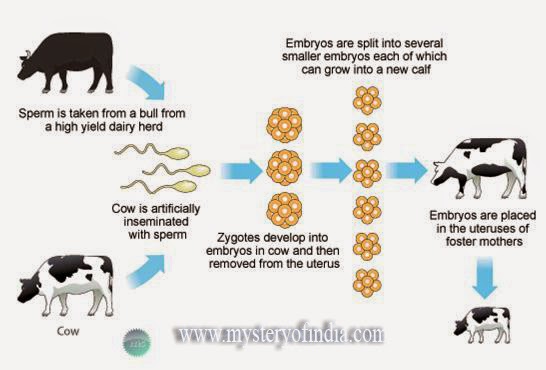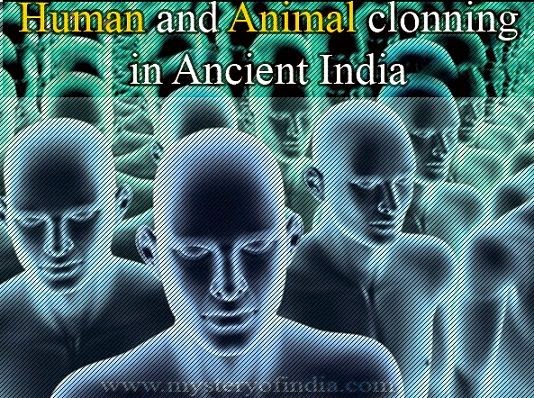Cloning is the scientific process of creating an exact replica of any living being. Such a clone has the same face, same body structure and same genetic code. This means DNA of clone is same as the DNA of the living being that was used to create a clone. Clone can be created from a single cell and thus, thousands and millions of replica can be created from a single living being by transfusing his/her living cell in an embryo of another living species.
In Vedic age, cloning of animals was done by sages to clone the species of powerful horses and productive cows. Ancient Indian produced a horse from another horse and a cow from the skin of a cow. Other achievements like Parthenogesis, Test-tube-baby etc are also reported in ancient literature of India.
When Dr. P.V. Vartak found mentioned in RigVeda about this miracle of human and animal cloning he told this finding to Augustus audience of scientists and doctors during May 1976, but everybody laughed, saying if the modern science can not do it, how is it possible for the Vedic people?
However after 21 years animal Cloning was done successfully in 1997 when a lamb was produced from udder of a sheep, which is a part of skin. Therefore the Vedic principle of cloning appears correct. Below are some of the stories on cloning from Vedic age.
In Rigveda, Rubhus are mentioned as brothers (Rubhu, Vajra and Vibhu) who brought youthfulness to their old parents. Their father was old but they were cloned young to bring back the youth of aging parents. They even managed to bring back their lost skills. (They must have used ayurvedic recipes to bring back youthfulness. So much literature about such recipes exist even today but is neglected). Additionally, they also created a cloned horse and cow. According to Dr. Vartak these experiments are done about 25000 years ago.
Cloning of Rubhus is mentioned by seven different sages in seven different verses of rigveda. All of these sages were from different generations thus depicting that such a technology existed over a long period of human life and Rubhus Brothers were famous for a prolong period proving greatness of their work.
The first work of Rubhus was to bring back youthfulness to their old parents. These seven sages are Kanva Medhatithi (1-20-4), Angirasa Kutsa (1-110-111), Dheerghatamas (1-161), Vishwamitra (3-60), Vamadeva (4-33), Vaisistha Maitravaruni (7-48) and Sharuna Arbhava (10-176) and the hymns they composed on Rubhas are as follows:
- 1-20-4: With their exclusive power they made their old parents youthful again.
- 1-110-8: They made their old parents full of youth again by their skill.
- 1-111-1: Ingenious Rubhus prepared a chariot for Indra, prepared two powerful horses (2nd being cloned from 1st), made their old parents youthful again and gave new mothers to orphaned calves or children.
- 1-161-7: Oh Rubhus, with the power of your intelligence you converted your old parents into youthful state.
- 4-33-3: Rubhus who made their old parents youthful again may come to our Yajna.
- 4-34-9: Rubhus gave a new life to their old parents, to Aswinau, to a cow and a horse.
- 4-35-5: Oh, ingenious Rubhus, you made your old parents youthful again.
- 4-36-3: Oh, Rubhu, Vaja and Vibhu, your workmanship of making your old parents youthful again was praised by gods.
Some of the Verses on cloning along with their translation are as follows:
Rigveda, Book 1, Hymn 20, verse 4
युवाना पितरा पुनः सत्यमन्त्रा रजूयवः |
रभवो विष्ट्यक्रत ||
Translation: With their exclusive power they made their old parents youthful again.
Rigveda, Book 4, Hymn 33, verse 3
पुनर ये चक्रुः पितरा युवाना सना यूपेव जरणा शयाना |
ते वाजो विभ्वां रभुर इन्द्रवन्तो मधुप्सरसो नो ऽवन्तु यज्ञम ||
Translation: Rubhus who made their old parents youthful again may come to our Yajna.
These eight evidence proves that hey had definitely made their old parents youthful. It show that they were expert in medical science. This miracle is not yet done by any scientist in modern world.
During the age when Rubhus were born, there was shortage of milk and cloning was essential to produce high-yielding cows. So, next task of Rubhas was to create a high-yielding cow that yields copious milk (RigVeda 1-20-3). Puranas describes this method in details where skin from cow’s back in taken and cells are multiplied from it to produce a new cow (named Viswaroopa) which looks alike.

Rigveda, Book 1, Hymn 110, verse 8
निश्चर्मण रभवो गामपिंशत सं वत्सेनास्र्जता मातरं पुनः |
सौधन्वनासः सवपस्यया नरो जिव्री युवाना पितराक्र्णोतन ||
Translation: Out of a skin, O Rubhus, once ye formed a cow, and brought the mother close unto her calf again.
Third work of Rubhus brothers was to produce two powerful horses. First they created a horse (named Hari) and presented it to Indra. Then they produced another horse which is a clone of Hari and now both were used to yoked to his chariot (1-161-7, 4-33-10).
Considering all these facts we have to admit that the creation of a horse Hari from another horse and creating a cow Vishvaroopa from a skin of a cow were experiments of cloning, just like that of producing a lamb Dolly from a sheep. During 1997 many newspapers compared the scientists, who prepared Dolly by cloning, with Gods. In the same way the Rubhus were compared with the Gods by the Vedic Sages. (1-161-6,7)
Before cloning, Rubhus brothers seem to have worked on living cells and their multiplication.
Sun gave Amruta in a Chamasa to Rubhus (1-110-3) and they divided it into four equal parts.
Chamasa here can be considered as a cell and amruta means Immortal thing or life. Therefore a Chamasa full of Amruta is a cell full of life, a living cell.
RigVeda (1-110-3) calls it Chit–Chamasa. Chit Means energy or rather life energy. From this we can imagine a pot containing life energy. It is nothing else but a living cell or a living animal or a plant. The basics unit of life is a living cell. Therefore Chit-Chamasa means a cell full of life.
A fertilised egg can be called as ‘Chit Chamasa‘ because it is a living cell and has capacity to divide and redivide to form billions of cells. It was divided into four by Rubhus, which means Rubhus evolved four animals from a single zygote or fertilised ovum.
During the experiment, eldest brother (Rubu) said, “we can make two cells from the original one” (4-33-5). However, the younger(Vajra) brother said, “We can make three” , because he observed that when one cell was divided into two, there were three cells. The youngest brother(Vibhu) observed and said , “We can make four”, as second cell also can be divided equally like the first.
Rubhus had also made a chariot flying (Vimana) in air, so they were automobile engineers too.
Next was human cloning, which is mentioned in story of King Vena.
He was a great king but became evil and corrupt. So, Mother Earth (Bhoodevi) decided that she would not provide crops to humans anymore.
A group of Rishis (Sages) killed King Vena out of anger. They removed all the evil from his corpse’s thigh. Then they created his clone from his arm. This clone had similar body but however, mind cannot be cloned. So, a new King who was named ‘Prithu’ was created with pure mind. He brought back Mother Earth (Bhoodevi) to her normal state and promised be her eternal guardian. This is why Earth (Bhoodevi) is also known as Prithvi.
Shrimad Bhagawata (4/15) states that the sages, later, also had cloned a girl from the left hand of king Vena. This girl later married Pruthu. Such type of experiment of producing a male and a female from a dead male is not yet done in the modern science.
There are examples of abnormal cloning, like of Nishada in Vishnu Purana. Nishada, though an abnormal clone, could live long and could produce children. His tribe was known after his name and King Nala (of the famous Nala-Damayanti story in Mahabharata) and Ekalavya were his descendants.
There are many more instanced like the demon ‘Rakta Beeja’ or AhiRavana and Mahi-Ravana who produce Rakshasas(demons) who look like them from their blood drops in war. It might be cloning from the white blood corpuscles, which contain nuclei.
Similar other clones are also reported in the Puranas. Lord Ganapati was produced from the ‘Mala’ (ey), which means the superficial layers of skin of Parvati. This is possible according to the modern science.
Source: Medical Science from ancient Indian Shastras.




Superb post however I was wanting to know if you could write a litte more on this subject?
I'd be very thankful if you could elaborate a
little bit further. Many thanks!
[…] Vyasa relied on the principle of ‘Chamasa division’ (Division of Living cells), laid down by Rubhus brothers in the Rigveda and worked further to give birth to 100 Kaurawas. Following Vyasa the modern […]
superb article
Google
Usually posts some pretty intriguing stuff like this. If youre new to this site.
F I C T I O N. Just because it was written ages back, doesnt make it any less of fiction. Even today, people write all kinds of fiction. If some of them come true a few centuries later, we cannot claim that it existed today !! Such a load of fake news… Anyway, it makes for an interesting read as to how people resort to writings in the past to justify their beliefs. Bible and Koran have a ton of such stories as well… doesnt make them any more real than this.